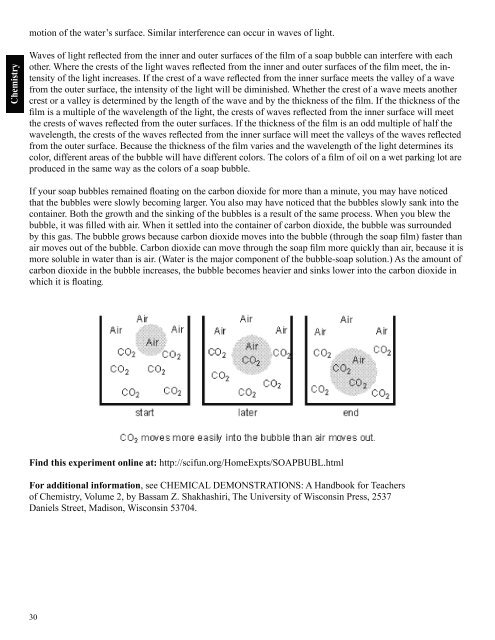ScienceMakers Toolkit Manual - The History Makers
ScienceMakers Toolkit Manual - The History Makers
ScienceMakers Toolkit Manual - The History Makers
You also want an ePaper? Increase the reach of your titles
YUMPU automatically turns print PDFs into web optimized ePapers that Google loves.
Chemistry<br />
motion of the water’s surface. Similar interference can occur in waves of light.<br />
Waves of light refl ected from the inner and outer surfaces of the fi lm of a soap bubble can interfere with each<br />
other. Where the crests of the light waves refl ected from the inner and outer surfaces of the fi lm meet, the intensity<br />
of the light increases. If the crest of a wave refl ected from the inner surface meets the valley of a wave<br />
from the outer surface, the intensity of the light will be diminished. Whether the crest of a wave meets another<br />
crest or a valley is determined by the length of the wave and by the thickness of the fi lm. If the thickness of the<br />
fi lm is a multiple of the wavelength of the light, the crests of waves refl ected from the inner surface will meet<br />
the crests of waves refl ected from the outer surfaces. If the thickness of the fi lm is an odd multiple of half the<br />
wavelength, the crests of the waves refl ected from the inner surface will meet the valleys of the waves refl ected<br />
from the outer surface. Because the thickness of the fi lm varies and the wavelength of the light determines its<br />
color, different areas of the bubble will have different colors. <strong>The</strong> colors of a fi lm of oil on a wet parking lot are<br />
produced in the same way as the colors of a soap bubble.<br />
If your soap bubbles remained fl oating on the carbon dioxide for more than a minute, you may have noticed<br />
that the bubbles were slowly becoming larger. You also may have noticed that the bubbles slowly sank into the<br />
container. Both the growth and the sinking of the bubbles is a result of the same process. When you blew the<br />
bubble, it was fi lled with air. When it settled into the container of carbon dioxide, the bubble was surrounded<br />
by this gas. <strong>The</strong> bubble grows because carbon dioxide moves into the bubble (through the soap fi lm) faster than<br />
air moves out of the bubble. Carbon dioxide can move through the soap fi lm more quickly than air, because it is<br />
more soluble in water than is air. (Water is the major component of the bubble-soap solution.) As the amount of<br />
carbon dioxide in the bubble increases, the bubble becomes heavier and sinks lower into the carbon dioxide in<br />
which it is fl oating.<br />
Find this experiment online at: http://scifun.org/HomeExpts/SOAPBUBL.html<br />
For additional information, see CHEMICAL DEMONSTRATIONS: A Handbook for Teachers<br />
of Chemistry, Volume 2, by Bassam Z. Shakhashiri, <strong>The</strong> University of Wisconsin Press, 2537<br />
Daniels Street, Madison, Wisconsin 53704.<br />
30










